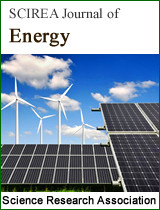Studies on Biogas Generation and Heat Efficiency from Cow dung and Poultry waste
DOI: 195 Downloads 15535 Views
Author(s)
Abstract
Abstract The study was carried out to produce biogas from cow dung and poultry wastes. The study was also carried out to determine the heat efficiency of each of the biogas produced. Nineteen litre bio-digesters and gas collection systems were fabricated using locally available materials. The respective organic materials used for the feed stock were collected locally. The slurry was prepared from each of the wastes by mixing with five litres of clean water. Water dispenser bottles were used to digest slurries of cow dung and poultry wastes. The wastes were digested and analyzed in accordance with standard methods. The physico-chemical parameters and gas yields were monitored daily. The average digester temperatures during the study were within the mesophillic range (24-37°C) which is best for methanogens. The pH values were within the optimal range 7.0 and 7.5. The total gas yields were 826m1 and 286.3m1 for cow dung and poultry wastes. A domestic heating test was carried out for the two substrates digested using the biogas produced to raise 1 litre of water to boiling point (100°C). The time expended was recorded in minutes as follows- 7.42 mins,7.46mins for cow dung and poultry wastes using a stop watch. The experimental procedure lasted for 14 days. The study revealed that cow dung had the highest heat efficiency and cooking rate while Poultry wastes had the lowest heat efficiency.
Keywords
Keywords: Cow dung, Poultry wastes, Bio-digester, Slurry, Heat efficiency, Biogas
Cite this paper
Daniel, U.I, Iheukwumere,R.I,
Studies on Biogas Generation and Heat Efficiency from Cow dung and Poultry waste
, SCIREA Journal of Energy.
Volume 4, Issue 3, June 2019 | PP. 51-61.
References
| [ 1 ] | Ayu and Aryati V.D. (2010). Biogas production using anaerobic biodigester from cassava starch effluent with ruminant bacteria as biocatalyst. Thesis Dissrtation, Chemical Engineering Department Technical Faculty Diponegoro University,Semarang. |
| [ 2 ] | Eze,J.I. (1995). Studies on generation of biogas from poultry droppings and rice husk from a locally fabricated biodigester. M.Sc. Dissertation, University of Nigeria, Nsukka, 64-65. |
| [ 3 ] | Igboro, S.B. (2011). Production of Biogas and Compost from Cow dung Zaria, Nigeria, unpublished PhD Dissertation presented to the Department of water resources and environmental engineering, Ahmadu Bello University, Zaria University. |
| [ 4 ] | Joy, W and idris, A. (2014). Preliminary study on biogas production of biogas from municipal soild waste (MSW) leachate. Journal of Engineering Science and Technology, 4(4): 115-117. |
| [ 5 ] | Karki, A. (2005). From kitchen waste to biogas: An empirical experience In: BNRM, No.75. 115 |
| [ 6 ] | Lay, J.I.,Noike, T., Endo,G and Ishimoto, S. (1997). Analysis of Environmental factors affecting methane production from high solid organic waste. Waste Sci., and Tech., 36(6-7): 639-650. |
| [ 7 ] | Mookherjee, I,Maity, A., Hassan,M., Ahmed,F., Sinha,P.K (2017). Investigation of Biogas Generation from foodwaste. International Journal of Innovative Research in Science, Engineering and Technology. 6(6): 10211-10216. |
| [ 8 ] | Mshandete, A.M and Parawira,W. (2009). Biogas Technology Research in Selected Sub-saharan Africa. African Journal of Biotechnology, Vol. 8(2), pp.116-125. |
| [ 9 ] | Parawira, N and Mshandete, N.N. (2009). Biogas Production and Utilization. Ann Arbor: Ann Arbor Science Publisher. |
| [ 10 ] | Sasse, L. (1988). Biogas plants; a publication of the Deutsches Zentrum fur Entwicklungstecnologien- GATE in: Deutsche Gesellschaft fur Technische Zusammenarbeit (GTZ) GmbH. |
| [ 11 ] | Schmitz T.D. (2007). Feasibility study for a National Domestic Biogas programme in Tanzania. |
| [ 12 ] | Tajidin,N.E, Ahmad S.H., Rosenani, H.,Azimah and Munirh, M. (2012). Chemical composition and citral content in Lemon grass (Cymbopogon citratus). Essential oil at three maturity stages. African Journal of Biotechnology 2685-2693. |
| [ 13 ] | Verma, S. (2002). Anaerobic Digestion of Biodegradable Organics in Municipal Solid wastes. Unpublished M.Sc. Thesis, Department of Earth and Environmental Engineering, Fu Foundation School of Engineering and Applied Science, Colombia University. |
| [ 14 ] | Weiland, P. (2010). “One and Two-step Anaerobic Bioconversion of Solid Agroindustrial Residues.” Water Science & Technology 27(2): 145-151. 2005-2007. Green project alternatives for food processor’s wastewater Michigan State University. |

